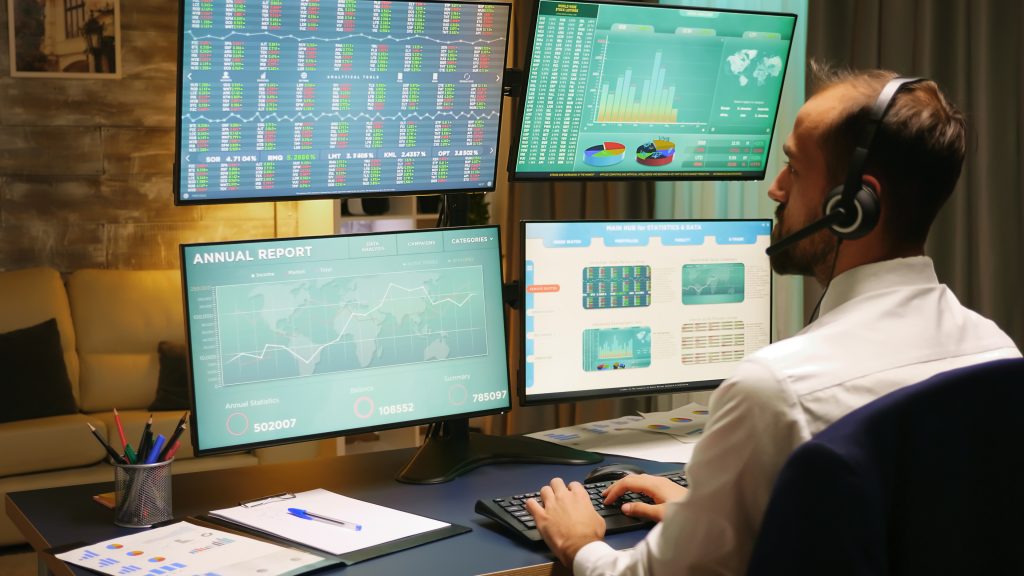Desktop Interoperability on the Trading Desk
February 9, 2021 | By: FlexTrade Insights

Everyone is talking about the desktop interoperability (interop) movement, collaboration, and open Application Programming Interfaces (APIs). It’s a sign of the evolution of the modern desktop in capital markets where traders want a better user experience, more efficient workflows, and seamless data shared across applications.
We are seeing the desktop interop movement gain momentum as banks, brokers, and asset managers have experienced the challenges of integrating trading applications during the pandemic. In fact, the COVID crisis has accelerated the demand for desktop interoperability.

“In normal times, the buy-side trader navigates eight to ten screens with different applications and data feeds opened in different windows. But since the pandemic, most traders working from home have two-to-four screens at best, resulting in limited screen space,” observed Andy Mahoney, Managing Director EMEA at FlexTrade.
Last year, an executive with Wellington Management stood up at an industry conference and told attendees that traders had to log into as many as 27 applications during the day, noted Dr. Robert Barnes, CEO of market operator Turquoise on a recent video with Openfin. “Now that the buy-side firm was going multi-asset, it was running out of desktop space, so they were going to embrace Openfin,” said Barnes on the video. Inspired by Wellington’s – “call to action,” Turquoise decided to learn about Openfin, the fintech innovator, which had pioneered the FDC3 standards, a common operating system (OS) for the financial desktop. That moment, said Barnes, reminded him of the 1990s when Fidelity Investments told its brokers that it no longer wanted fax machines and needed to send information electronically, resulting in the Financial Information Exchange – FIX Protocol.
Just as FIX became a global messaging standard for electronic trading, and is managed by the industry non-profit FIX Protocol Ltd., in 2018, Openfin contributed the FDC3 set of standards to the Fintech Open Source Foundation known as FINOS, where it’s part of the foundation’s open-source governance framework. Fast forward to the present and Openfin, and the other desktop interop innovators Cosaic (Finsemble), and Glue42 are providing a meta layer, which serves as a buffer for sharing data and context between applications.
Technologists at buy-and sell-side firms have embraced the FDC3 standard so they can build custom applications that consume data from third-party applications and create more efficient trader workflows. “Traders and portfolio managers often need to integrate specialized applications such as pre-trade, post trade, and risk analytics into the OMS and EMS blotter,” said Mahoney.
“FlexTrade is aware of the need to reduce context switching and we are supporting the FDC3 standard. We also see major benefits to the desktop interop movement in terms of helping us create more efficient workflows, visualizations, and data presentations,” said Mahoney. In April 2019, FlexTrade announced a partnership with Openfin to enable buy-side traders using FlexTRADER EMS to seamlessly integrate third-party vendor applications already deployed on the Openfin OS into their workflows.
TimeLine
While the pendulum is shifting to open systems, the desktop interop movement is in different stages of evolution.
In the front office, which is most advanced, third-party vendors use APIs to ingest data from different applications. Proprietary applications, built by asset managers and banks over the years are not necessarily, maintained in terms of integrating APIs, so there can be cutting and pasting of data.
“The starting point of this journey for FlexTRADER EMS was the open architecture, as we’ve talked about for many years, around integrating with Symphony’s messaging application and OTAS for pre-trade analytics through native APIs,” said Mahoney.
Last year, FlexTrade collaborated with Turquoise Plato Uncross, a buy-side multilateral trading facility (MTF) in the London Stock Exchange Group, on bringing its data onto the EMS desktop through the Openfin bus based on FDC3. “Essentially, it’s depicting how much volume has crossed in Turquoise Plato Uncross that day in real time as a multiple of the order quantity on the blotter,” explained Mahoney. “Turquoise Plato is sending that data to FlexTRADER EMS via the Openfin information bus, and it allows us to run a calculation on the amount traded in Turquoise, which could cause the buy-side trader to consider Turquoise as a destination,” he said.
For example, in a live demo by FlexTrade mentioned above, the EMS runs a calculation which could say: 20 times your order quantity has traded in Plato Uncross. “In this case, we’ve programmed an if/then rule that says, “when this situation happens, include Turquoise Plato’s liquidity,” and it automatically opens an order ticket. If trader wanted to automate this further, it could use our Algo Wheel functionality to execute the trade.”
Without Openfin, Turquoise would have presented its data to us in a custom format and FlexTrade would need to build to it. By pushing this data into Openfin so quickly based on the standard, FlexTrade solved the technical problem of presenting Turquoise’s data. This means FlexTrade’s developers can spend more of time on what kind of behavior we’re trying to influence from the buy-side trader.
The next natural evolutionary step is what Pictet Asset Management showed on a webinar in January by using Cosaic’s Finsemble to drive cross-application workflows involving foreign exchange pricing, money market yields and credit-instrument pricing. The focus was on collapsing “cumbersome workflows with multi-application switching that involved copying data and moving data around,” said Carl James, Pictet’s Global Head of Fixed-Income Trading Technology on the webinar. In the demo, Dan Benninger, Pictet’s investment platform integrator, proved that an OMS, Bloomberg terminal, and a proprietary FX pricing application were sharing data. With one click, traders were able to execute bonds via the OMS, while performing an FX hedge that drew prices from customized application. All the while, Finsemble was running in the background and communicating with each of these applications.
So, where is this headed in the future?
In the next five years, the industry is likely to see trading desktop to evolve where there is seamless interoperability of data between applications.
“Rather than having multiple different applications on multiple desktops, you can just have one seamless desktop. The starting point for that is if I am in my EMS and I want to do something in my OMS, you should be able to invoke that window to open in your EMS even though the system, the technology, the core is still your OMS,” said Mahoney.
Just as there is the iOS and Android on mobile phones enabling consumer apps to communicate with one another, there could be a meta-layer allowing trading applications like the OMS/EMS to call a service which could be a pre-trade or post-trade provider that has written to the Openfin message bus.
Not only will this enable traders to work more efficiently, but it will lower the cost of integration. While the desktop interoperability is still emerging, it will transform the institutional trading desk over time.